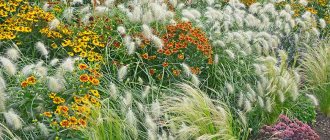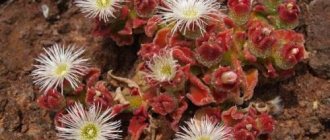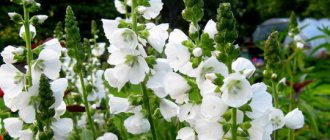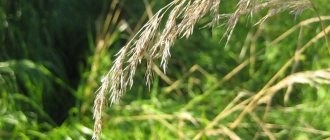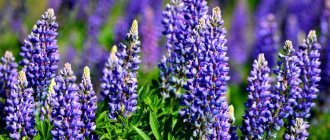A flower never appears on a state's coat of arms by accident. Its presence there speaks of the inextricable connection of the people with a certain plant culture - a connection that goes back centuries. Therefore, the coats of arms of the countries of Central Asia feature cotton, and the Belarusian symbol of the state features flax and clover.
Just a few centuries ago, flax was everything for European peoples:
- food - sunflower oil was not known then;
- clothes - very wearable and useful to the body;
- weapons and implements - linen ropes were used by both the merchant and military fleets, and bags and matting were common packaging material and containers).
But in addition to the practical benefits of fiber and oil, this plant also has stunning flowers - such pure and frank, disarming blueness is not found anywhere in nature. It is no coincidence that in order to flatter a girl with “standard” gray eyes they say that her eyes are blue and soft, like flax.
Flower breeders, who can never resist further improving what is already perfect, did not ignore this flower - this is how varieties appeared not only with a natural blue color, but also white and various shades of pink-red, and many different color combinations (including those with a large corolla diameter).
But besides them, there is also an originally large-flowered species - Linum grandiflorum (or Adenolinum grandiflorum - a synonym proposed by Weber) of burgundy-red color, described by the French botanist Defontaine back in 1798, still growing in its original state in north-west Africa .
Linum grandiflorum
Although its arrival in the south of Europe did not contribute to its well-being - it led to feralization and grinding, nevertheless it became an excellent material for selection and now the number of varieties of large-flowered (or large-flowered) flax can no longer be accurately counted.
Brief description of the genus
There are about 200 species in the flax genus, among which the most interesting for a gardener are low-growing compact bushes up to half a meter high, most of them perennials. Flowers can be of various sizes, from small to large, and the color of the corollas is blue, red-pink and white. The shoots are thin, but very strong, thanks to which the plant retains its shape even in unfavorable weather conditions.
Flax is naturally widespread in Africa and North America and is found in some places in Europe and Asia. In the conditions of the Middle Zone, it is successfully cultivated by flower growers, because flax perceives the conditions of a temperate climate as comfortable.
Combination with other plants
In order for flax to take root well in the garden plot and become a worthy decoration, remember that the best combination of the plant is observed mainly with crops that have a similar development pattern and growing conditions.
Linen in landscape design
Gardeners love to use perennial blue flax in a variety of group compositions: in flower beds, flower beds, mixed borders, colorful borders and even rock gardens.
An excellent combination of flax is observed with sun-loving and moisture-resistant plants. Perennial flax grows surprisingly well on Moorish lawns. It will ideally play in tandem with chamomile, marigolds, cornflowers and clover.
As we can see, perennial blue flax is a wonderful plant that, with very little effort on your part, can respond with the beauty of its blue petals decorating your garden plot. Good luck!
Types of flax
Perennial flax Linum perenne
Perennial flax (Linum perenne) is quite winter-hardy - zone 4-5 (frosts up to -26 - -34 ° C), depending on the variety. Therefore, the plant can be grown even in areas with harsh winters. The height of the bushes with peduncles is 20-80 cm, they are densely covered with numerous flowers up to 2-3 cm in diameter. Perennial flax blooms from early spring to late autumn; flowering is more abundant if faded buds are removed in time, preventing the seeds from ripening.
Annual flax photo
Seed flax, or annual flax, or common flax (Linum usitatissimum) is the same flax that our ancestors grew in order to obtain fiber from which they wove unique natural fabric. From it they obtained oil with a lot of useful and medicinal properties. Various decoctions, tinctures, and compresses from flaxseed were also used for medicinal purposes. Seed flax can be tall (0.9-1.5 m), medium-growing (0.7-0.8 m) and low-growing (0.3-0.6 m), depending on the variety.
Grandiflorum flax Rubrum Linum grandiflorum 'Rubrum'
Large-flowered flax (Linum grandiflorum) is a bright, beautiful annual with large pink-red, blue, white, pale pink flowers, with red or black centers, up to 3 cm in diameter. It is grown exclusively for decorative purposes. The height of the bushes is 30-60 cm, but there are varieties up to 1.1 m high. It can be grown up to the north of the taiga zone.
Brief information about decorative flax
Flax forms not very dense bushes with delicate flowers and graceful narrow leaves. The diameter of flax flowers is about 1.5-2 cm (in simple varieties), and about 4-6 cm (in more elite varieties).
Flowering is long: from early summer to September-October. The flowers bloom in the morning (in sunny weather), and the petals fall off in the evening. That is, only one flower blooms, but new inflorescences open every day, so the bush does not lose its decorative effect.
Quite large seeds ripen in the seed pod, which you can collect with your own hands and sow them later. Germination lasts three years.
The most decorative type of crop is the annual large-flowered flax (pictured below). It is distinguished by charming flowers, longer flowering and unpretentiousness. This variety has a height of about 0.4-0.6 m. The diameter of the flowers is about 3-5 cm. The standard color of large-flowered flax is red.
As an ornamental plant, you can grow another variety: annual flax (or flax ). Illustrated in the photo below. The flowers of this annual are colored blue and have incredible tenderness and airiness.
Other types of annual and multi-year ice are also decorative. You can purchase perennial flax and grow it on your site. The plant blooms in the second year of planting.
Decorative flax (large-flowered, ordinary and others) helps to implement various garden solutions. The plant is perfect for:
- Moorish lawn;
- rock garden and rock garden;
- mixborders;
- village front gardens;
- decorating clearings or empty, boring areas in the garden.
- borders;
- creating a garden in a natural style.
Large-flowered or ordinary flax (as well as other types) combines beautifully in a flower garden with the following crops: cornflower (garden chamomile), cornflower, eschscholzia.
Annual flax is very unpretentious and undemanding. Grows well in sunny areas, is resistant to drought, and tolerates light frosts. There are no special requirements for the soil, but it achieves greater decorative value on light, nutritious, drained, water- and breathable soil.
You should not grow the crop in areas with stagnant moisture or in very windy or dark locations.
Sowing seeds in the ground
Flax seeds photo
Flax seeds can be sown directly into the ground in early spring at the first opportunity to go into the field or before winter, when the ground freezes slightly (or after the first snow). The seeds are not afraid of frost, the main thing is that they do not sprout in the warm autumn. Then, covered with snow, they will successfully overwinter and emerge together in the spring at the first warmth. You should not sow flax in the fall when it rains or the weather is damp. There is a risk of damping off in this case. There is no need to cover the seeds; it is important to simply make sure that there is snow above the crops in winter.
In spring you can sow all spring from the end of April and even in summer, but the earlier the better. Simply scatter the seeds over the surface of the soil and work them into the soil with a rake. You can also sow in rows: planting depth is 1.5-2 cm, row spacing is 20 cm. Be sure to water so that seedlings appear faster and do not die from drought.
Flax seedlings tolerate frosts down to -3°C, so you don’t have to worry that they will die in the spring. Flax blooms 1.5-2 months after germination.
Plant propagation
Perennial flax is propagated in several ways:
- Seeds. As we already know, propagation by seeds is possible both in spring and autumn (when seed material is sown in winter). The seeds are carefully laid out on the ground (without digging into the soil) and slightly moistened with water. By the way, perennial varieties can be safely grown even in the summer. When grown in containers (meaning a permanent place, since the seedling method of growing flax with subsequent transplantation is ineffective), removal to an open place is carried out immediately after sowing.
- Dividing the bush. This propagation method is relevant for two-year-old plants. The process of separating several parts from the mother bush is usually carried out in mid-spring, or after the end of the flowering period - in August. Parts of the bush are usually planted at a distance of about 20 cm from each other. They require constant watering and protection from direct sunlight.
Growing seedlings and planting in the ground
Decorative flax seedlings photo
The most impatient gardeners can grow flax seedlings at home. You can start growing seedlings from early to mid-March. Prepare seedling cassettes and plant seeds one at a time per cell. If there is no space, sow in a common container or large glass, but then you will need to pick and plant in separate containers when the seedlings grow up. For sowing, use ready-made seedling substrate. Be sure to moisten the crops with a spray bottle and place them on a warm, sunny windowsill. If the weather is cloudy and there is little light, organize additional lighting.
You can cover the crops with film to retain moisture and heat, but as soon as shoots appear (usually flax sprouts after 5-6 days), the cover must be removed immediately.
Further care of the seedlings is simple: timely, regular watering without stagnation of moisture and drying out of the soil. You can carry out 1-2 feedings with an interval of at least 10 days. We transfer the grown seedlings into larger cups or pots.
When the seedlings grow up and the weather is good outside, take them out into the garden or to the doorstep of the house to gradually harden them. Leave it for a short time at first, then for half a day, all day, then - and overnight (if there is no frost). When the seedlings get used to the conditions of open ground and the night frosts recede, feel free to plant the seedlings in a permanent place.
We prepare the holes for planting seedlings in advance according to the size of the earthen ball; it is useful to put a handful of humus in them. The distance between the holes is 10-20 cm. After planting, the plants are well watered.
Planting in open ground
The answer to the question of when to plant seeds depends entirely on the climate. Where it is warm enough, they are sown immediately in the proper place, either in the spring or right in the fall - and with the first warmth, healthy seedlings that have undergone natural stratification are obtained, which makes it possible to have a flowering array of crops already in the year of planting.
When planting in summer, you can count on flowering only next year.
Where the climate is cold, they resort to propagation by seedlings, initially sowing seeds in a greenhouse (approximately in April; if planted in March, flax is guaranteed to bloom in the same year). If the soil is sufficiently warmed and the night temperature is not lower than 12°C, seedlings from ground sowing appear on the 10-15th day.
The requirements for a summer cottage are not too stringent. If there is a free, bright place in the yard (even on an ownerless and useless slope) and the soil does not suffer from stagnant moisture, that’s already great; if it is also alkaline, that’s doubly great.
You can, of course, allow flowers to grow on poor soil, but this will affect the flowering - it will be more modest. In order to plant flax correctly, it is better to fill the soil for sowing with fertilizers, both organic and mineral - but within reason.
Linum Flavum Compactum
How to care for flax in the garden
As already noted, flax is very unpretentious: it is drought-resistant, tolerates extreme heat and sharp gusts of wind. But still, he needs your attention. Be sure to remove weeds from the area and water 1-2 times a week in dry, hot weather. If it sometimes rains, but the ground remains slightly damp, you should not flood the flax: it does not like it. It’s the same in the fall: if it rains, watering is stopped.
It is not necessary to feed, but if you really want to enhance the flowering and lushness of the bush, feed with potassium-phosphorus fertilizers or complex fertilizers with an NPK complex once a month (you can at the beginning of flowering, and then after a month and that’s it). Use nitroammofoska, complex fertilizers for flowering plants.
Perennial flax: types and varieties, features of cultivation and care
A gardener, when choosing flowers for the garden, often undeservedly deserves paniculate flax. The fact is that this flower has long been considered an excellent decoration for the home, which can also protect it. This culture is unpretentious, but at the same time has a relatively high decorative value, as it has very beautiful flowers. There is an opinion that the flowers of this plant should be painted blue, but this is not so.
Description of perennial blue flax
Flax is a herbaceous plant. This genus includes about 200 very diverse species. Often flax is not very large bushes, the height of which does not exceed 50 centimeters. Although the shoots are very thin, they are relatively strong. Flowers vary in size, from very large to small. They can be white, bluish or reddish pink.
This plant is widely grown by gardeners in the Midlands. It grows well in temperate climates, so it is found in Africa and North America, as well as parts of Asia and Europe.
Types and varieties of flax
Of all the known types and varieties of flax, the following are the most popular among gardeners:
Oilseeds. This ornamental variety is often grown indoors. Most often, this plant is grown to produce flax seeds, which have high nutritional value and medicinal properties. As a rule, the bush does not exceed 0.3 m in height. The flowers are not very large. They can be painted in yellow, blue, and also red shades. Ornamental. This species is unpretentious, so even a person far from gardening can grow. In addition, you should know that various decorative varieties of flax are used in the manufacture of durable fabrics from which clothes, underwear, etc. are sewn. Until recently, this flax variety was cultivated in mid-latitudes. However, in this short time, it managed to become one of the most popular varieties among gardeners. The height of a medium-sized bush usually does not exceed 50 centimeters. The flowers of this variety are very large and can be painted in various shades of color. Such a plant is perennial; if it is provided with favorable growth conditions, it can be grown in one place for five years without replanting. Flax multiflora. This variety is the most common compared to others. Very attractive bushes made from such flax are used to decorate edgings, flower walls, etc.
Planting flax in open ground
Flax is not very picky about growing conditions, which greatly simplifies the choice of a suitable place for planting it. However, if you want it to grow and develop normally, it should be planted in an open, sunny place, without shade from bushes, trees or other buildings. If your region does not have many sunny days, it is unlikely that you will be able to grow perennial flax.
This plant is also undemanding to soil. It can be grown in almost any soil except waterlogged soil. When planting, choose an area with light soil where the groundwater is relatively deep. Perennial flax can be grown successfully on moderately steep slopes.
It is recommended to sow seeds of perennial flax varieties in boxes at home. If you live in a region with a relatively mild and warm climate, you can also plant the seeds outdoors. It is not recommended to bury them in the ground. The seeds are evenly sprinkled on the surface of a previously prepared area, and then moistened with water from a sprinkler. Sowing seeds in open ground is possible in the spring (in warm weather and the daytime temperature is about 20 degrees) and in the fall (you need to do it before the onset of cold weather and the average air temperature during the day should be at least twenty degrees).
If you are going to sow perennial flax in open ground, then do not forget to take into account the cold factor. Sowing on a rainy or humid day is strictly prohibited. The planting area should be covered with a light layer of soil and then insulated in the same way as most garden flowers.

